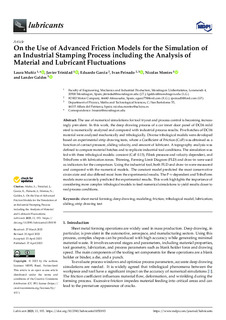Título
On the Use of Advanced Friction Models for the Simulation of an Industrial Stamping Process including the Analysis of Material and Lubricant FluctuationsFecha de publicación
2023Otras instituciones
FORD MOTOR COMPANYhttps://ror.org/01tnh0829
Versión
Version publicadaTipo de documento
ArtículoArtículoIdioma
InglésDerechos
© 2023 The AuthorsAcceso
Acceso abiertoVersión de la editorial
https://doi.org/10.3390/lubricants11050193Publicado en
Lubricants Vol. 11. N. 5. N. art. 193, 2023Editorial
MDPIPalabras clave
sheet metal forming
deep drawing
modeling
friction ... [+]
deep drawing
modeling
friction ... [+]
sheet metal forming
deep drawing
modeling
friction
tribological model
lubrication
sliding
strip drawing test [-]
deep drawing
modeling
friction
tribological model
lubrication
sliding
strip drawing test [-]
Resumen
The use of numerical simulations for tool tryout and process control is becoming increasingly prevalent. In this work, the deep drawing process of a car inner door panel of DC06 mild steel is numerica ... [+]
The use of numerical simulations for tool tryout and process control is becoming increasingly prevalent. In this work, the deep drawing process of a car inner door panel of DC06 mild steel is numerically analyzed and compared with industrial process results. Five batches of DC06 material were analyzed mechanically and tribologically. Diverse tribological models were developed based on experimental strip drawing tests, where a Coefficient of Friction (CoF) was obtained as a function of contact pressure, sliding velocity, and amount of lubricant. A topography analysis was defined to compare material batches and to replicate industrial tool conditions. The simulation was fed with three tribological models: constant (CoF 0.15), Filzek pressure and velocity dependent, and TriboForm with lubrication zones. Thinning, Forming Limit Diagram (FLD) and draw-in were used as indicators for the comparison. Using the industrial tool, both FLD and draw-in were measured and compared with the numerical models. The constant model predicted the most conservative strain state and also differed most from the experimental results. The P-v-dependent and TriboForm models more accurately predicted the experimental results. This work highlights the importance of considering more complex tribological models to feed numerical simulations to yield results closer to real process conditions. [-]
Colecciones
- Artículos - Ingeniería [758]
El ítem tiene asociados los siguientes ficheros de licencia:






















